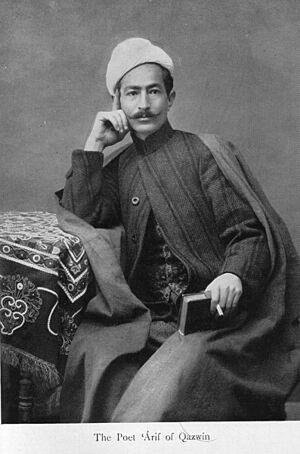Aref Qazvini facts for kids
Abolqassem Aref Qazvini (Persian: ابوالقاسم عارف قزوینی) was an important Iranian poet, songwriter, and musician. He was born in 1882 and passed away on January 21, 1934.
A Life Dedicated to Iran
Aref Qazvini was born in the city of Qazvin. He wrote many poems about Iran and was known as a national poet. Besides his strong poems, he also wrote words for many songs and played music.
He was a revolutionary during the Iranian Constitutional Revolution. This was a time when people in Iran wanted more freedom and a fairer government. Aref wrote many songs that supported this movement and encouraged people to fight for their rights.
Later in his life, he moved to Hamadan, where he died in January 1934 at the age of 52. After he passed away, all his works were published in cities like Berlin and Tehran.
His Messages of Freedom
One of Aref's famous poems is called "- ناله مرغ اسیر" (which means "imprisoned bird's moaning"). In this poem, he invited his fellow Iranians to stand up for their freedom. He believed that Iran should not rely on help from other countries to grow. Instead, he felt that people should be ready to protect their country. He also suggested that the Shah, who was the most powerful person, might actually be against the people's wishes.
Aref wrote this poem during the Constitutional period. He was deeply inspired by his love for Iran and the growing desire for the country to be independent. Many people at that time wanted Iran to move forward and be modern, but they did not want to depend on powerful countries like Russia or England.
Symbols in His Poetry
Aref used powerful symbols in his poems:
- The imprisoned bird: This image represents people who felt trapped and unable to speak freely. By using this, Aref wanted to tell his countrymen not to stay silent. He warned that if they did, they might become sad and lose hope, just like a bird in a cage.
- The wind: In Persian literature, the wind often stands for freedom. Aref used it as a sign of hope, showing that the message of freedom could spread everywhere. The wind touches everyone, which meant that all Iranians needed to work together to save their country.
These symbols helped Aref question the way things were run. His poem encouraged ordinary people to stand up to those in power and fight for a better future for Iran.
See also
 In Spanish: Aref Qazviní para niños
In Spanish: Aref Qazviní para niños


